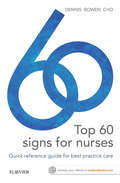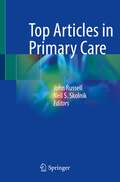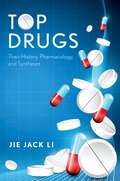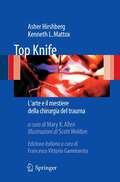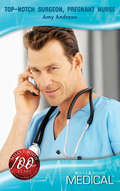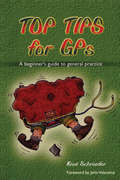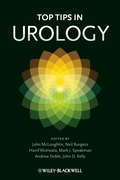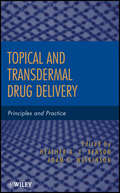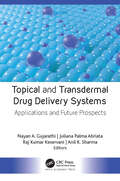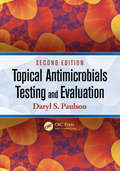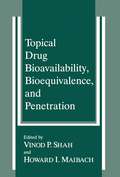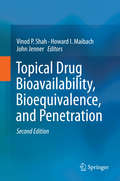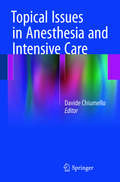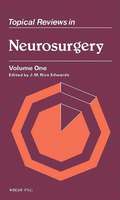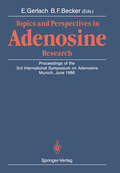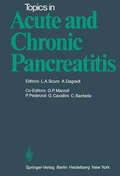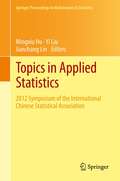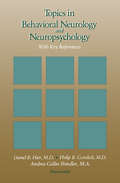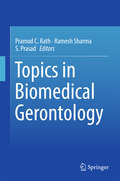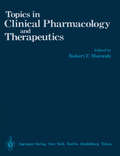- Table View
- List View
Top 60 Signs for Nurses - E-Book: Quick Reference Guide For Best Practice Care
by Mark Dennis William Talbot Bowen Lucy ChoPresented in a useful handbook style, Top 60 Signs for Nurses: Quick reference guide for best practice care outlines the evidence base and clinical value of each clinical sign to assist with interpretation. Each of the signs is related back to the mechanism of action along with clearly documented research to demonstrate the evidence base associated with this sign.Signs are ordered alphabetically within each chapter outlining a specific body systemExtensive reference lists of up-to-date literature strengthen the authority of the contentClinical Pearls highlight the main signs which students and graduate nurses should look out for to help them identify conditions with which the patients present
Top Articles in Primary Care
by John Russell Neil S. SkolnikThis book reviews, in one place, the breadth of articles that form the basis for the current practice of medicine. When physicians examine medical literature, there are articles that are quoted over and over again, as well as articles that have established the standards that are so embedded that we no longer think of where those standards came from. When clinicians treat patients with diabetes, why do we aim for an A1c less than 7%? That standard comes primarily from two trials, the DPPT and the UKPDS trial, both of which broke new ground when they were published. In addition, the ACCORD trial informed us that a lower A1c goal does not improve outcomes, and may in fact lead to worse outcomes. Understanding these trials helps physicians to make better decisions for their patients and gives them a greater appreciation for the information they work with every day.The chapters are organized by system such as respiratory, cardiovascular, diabetes, etc. and within each system, in the chronological order of publication. Each article reviewed includes a succinct overview of methodology and the results, followed by a discussion that puts the results into clinical context. All articles are selected and chapters written by primary care physicians who understand what is relevant to the intended audience for the book. Written by experts in the field, Top Articles Every Clinician Should Know provides readers with one source where information can be found about the most important articles published in the medical literature that informs the way clinicians practice primary care today.
Top Drugs: Their History, Pharmacology, and Syntheses
by Jie Jack LiDrugs like Lipitor, Plavix, Taxol, and Zoloft are integral in today's medicinal world. These widely used products save lives and improve the quality of lives, playing a crucial role in everything from cholesterol management to cancer treatment. These advances in medicine were brought into existence after nuanced process of creation, featuring a wide range of chemical and pharmacological experimentation and discovery. Top Drugs: Their History, Pharmacology, and Synthesis provides an in-depth study on ten prominent drugs, outlining the chemistry behind each one's creation. Jie Jack Li, a medicinal chemist and an expert on drug discovery, offers a thorough analysis of the landscape of current drug development. The comprehensive text is divided by health issues, including cardiovascular, cancer, metabolic diseases, and infectious diseases. Each section features individual chapters on significant drugs, outlining the chemistry and history of the drug's discovery. Li begins each chapter with the product's history, providing necessary context. Li then proceeds to describe the mechanism of action, structure-activity relationship (SAR), bioavailability, metabolism, toxicology, the discovery route, and the process route. Top Drugs: Their History, Pharmacology, and Synthesis will acclimate students, scientists, and interested laypersons to the world of chemistry and drug discovery.
Top Drugs: Their History, Pharmacology, and Syntheses
by Jie Jack LiDrugs like Lipitor, Plavix, Taxol, and Zoloft are integral in today's medicinal world. These widely used products save lives and improve the quality of lives, playing a crucial role in everything from cholesterol management to cancer treatment. These advances in medicine were brought into existence after nuanced process of creation, featuring a wide range of chemical and pharmacological experimentation and discovery. Top Drugs: Their History, Pharmacology, and Synthesis provides an in-depth study on ten prominent drugs, outlining the chemistry behind each one's creation. Jie Jack Li, a medicinal chemist and an expert on drug discovery, offers a thorough analysis of the landscape of current drug development. The comprehensive text is divided by health issues, including cardiovascular, cancer, metabolic diseases, and infectious diseases. Each section features individual chapters on significant drugs, outlining the chemistry and history of the drug's discovery. Li begins each chapter with the product's history, providing necessary context. Li then proceeds to describe the mechanism of action, structure-activity relationship (SAR), bioavailability, metabolism, toxicology, the discovery route, and the process route. Top Drugs: Their History, Pharmacology, and Synthesis will acclimate students, scientists, and interested laypersons to the world of chemistry and drug discovery.
Top Knife: L'arte e il mestiere della chirurgia del trauma
by Asher Hirshberg Kenneth L. MattoxQuesto libro si propone di impartire i consigli utili sul modo migliore per accompagnare il paziente traumatizzato grave in sala operatoria, organizzare il lavoro tuo e dell’équipe, sudare sette camicie per risolvere una situazione difficile, ma alla fine chiudere l’intervento con il miglior risultato possibile. In poche parole, una guida pratica sulla chirurgia del trauma destinata non solo agli specializzandi e ai tirocinanti, ma anche ai chirurghi generali interessati al trattamento dei pazienti traumatizzati e ai chirurghi che operano in condizioni difficili – ad esempio presso gli ospedali militari, i distretti rurali o nell’ambito di missioni umanitarie. Sull’atlante chirurgico impari a utilizzare le mani, ma certo non a ragionare, prevenire le mosse e improvvisare, mentre grazie ai nostri consigli pratici apprenderai che quando operi un paziente traumatizzato con emorragia massiva devi usare la testa, oltre che le mani. La prima parte illustra alcuni dei principi generali della chirurgia del trauma, soffermandosi non tanto su come si dovrebbe suturare, quanto piuttosto sulla necessità di sviluppare la capacità di pensare e programmare quando si sta davanti al tavolo operatorio. Purtroppo soltanto di rado, per non dire mai, queste capacità si apprendono frequentando le scuole di specializzazione. La seconda parte è dedicata alla chirurgia del trauma vista come uno sport da contatto: insegna come si trattano specifiche lesioni a carico dell’addome, del torace, del collo e dei vasi periferici, mettendo in particolare evidenza come le cose potrebbero non andare per il verso giusto, un aspetto quasi sempre tralasciato dai testi tradizionali. L’esperienza, invece, ci ha insegnato che imparare dove sono le insidie è essenziale se si vuole imparare ad operare. La lezione più importante che ci auguriamo tu possa trarre da questa guida è di scegliere sempre la soluzione più semplice, perché nella chirurgia del trauma è l’unica che non riserva mai sorprese e dà risultati.
Top-Notch Surgeon, Pregnant Nurse: Single Dad, Outback Wife / The Outback Doctor's Surprise Bride / Top-notch Surgeon, Pregnant Nurse (Brisbane General Hospital #1)
by Amy AndrewsEnter into the world of high-flying Doctors as they navigate the pressures of modern medicine and find escape, passion, comfort and love – in each other’s arms! One magical night.
Top Tips for GPs: A Beginner's Guide to General Practice
by Knut SchroederFor GPs and practice managers the challenge of the NHS reforms is to understand the business context in which general practice operates. Of the many skills learned from commerce and industry needed for the development of an effective strategy, business planning has been demonstrated to bring important benefits to the practice. However, for many the concept is necessary but unfamiliar. This book sets out to demystify the subject, explains the benefits and, by way of numerous examples, shows how they can be applied to the single-handed GP and group practices, whether or not they are fundholders. It suggests that good clinical care is not possible without the necessary planning and management skills to run a business.
Top Tips for GPs: A Beginner's Guide to General Practice
by Knut SchroederFor GPs and practice managers the challenge of the NHS reforms is to understand the business context in which general practice operates. Of the many skills learned from commerce and industry needed for the development of an effective strategy, business planning has been demonstrated to bring important benefits to the practice. However, for many the concept is necessary but unfamiliar. This book sets out to demystify the subject, explains the benefits and, by way of numerous examples, shows how they can be applied to the single-handed GP and group practices, whether or not they are fundholders. It suggests that good clinical care is not possible without the necessary planning and management skills to run a business.
Top Tips in Urology
by John McLoughlin Neil Burgess Hanif Motiwala Mark J. Speakman Andrew Doble John KellyThe second edition of Top Tips in Urology provides highly clinical tips and rapid-reference "tricks of the trade" to the most common questions and problems that arise for both the practicing urologist and the urologic surgeon. Covering each of the major areas of urology and with contributions for experience practicing urologists and surgeons, this book is a unique book containing valuable information for all urologists dealing with patients on a day to day basis.
Top Tips in Urology
by John McLoughlin Neil Burgess Hanif Motiwala Mark J. Speakman Andrew Doble John KellyThe second edition of Top Tips in Urology provides highly clinical tips and rapid-reference "tricks of the trade" to the most common questions and problems that arise for both the practicing urologist and the urologic surgeon. Covering each of the major areas of urology and with contributions for experience practicing urologists and surgeons, this book is a unique book containing valuable information for all urologists dealing with patients on a day to day basis.
Topical and Transdermal Drug Delivery: Principles and Practice
by Heather A. E. Benson Adam C. WatkinsonPractical drug development approaches presented by leading experts Designed to support the development of new, effective therapeutics, Topical and Transdermal Drug Delivery: Principles and Practice explains the principles underlying the field and then demonstrates how these principles are put into practice in the design and development of new drug products. Drawing together and reviewing the latest research findings, the book focuses on practical, tested, and proven approaches that are backed by industry case studies and the authors' firsthand experience. Moreover, the book emphasizes the mechanistic information that is essential for successful drug product development. Topical and Transdermal Drug Delivery: Principles and Practice is divided into two parts: Part One, Current Science, Skin Permeation, and Enhancement Approaches, offers readers a fundamental understanding of the underlying science in the field. It describes the principles and techniques needed to successfully perform experimental approaches, covering such issues as skin permeation, enhancement, and assessment. Part Two, Topical and Transdermal Product Development, guides readers through the complete product development process from concept to approval, offering practical tips and cautions from experts in the field. This part also discusses regulations that are specific to the development of dermal drug products. The final chapter explores current and future trends, forecasting new development techniques and therapeutics. Throughout the book, the authors clearly set forth the basic science and experimental procedures, making it possible for researchers to design their own experimental approaches and accurately interpret their results. With contributions from experienced drug researchers, this text is highly recommended for all researchers involved in topical and transdermal product development who need to know both the state of the science and the standards of practice.
Topical and Transdermal Drug Delivery: Principles and Practice
by Heather A. E. Benson Adam C. WatkinsonPractical drug development approaches presented by leading experts Designed to support the development of new, effective therapeutics, Topical and Transdermal Drug Delivery: Principles and Practice explains the principles underlying the field and then demonstrates how these principles are put into practice in the design and development of new drug products. Drawing together and reviewing the latest research findings, the book focuses on practical, tested, and proven approaches that are backed by industry case studies and the authors' firsthand experience. Moreover, the book emphasizes the mechanistic information that is essential for successful drug product development. Topical and Transdermal Drug Delivery: Principles and Practice is divided into two parts: Part One, Current Science, Skin Permeation, and Enhancement Approaches, offers readers a fundamental understanding of the underlying science in the field. It describes the principles and techniques needed to successfully perform experimental approaches, covering such issues as skin permeation, enhancement, and assessment. Part Two, Topical and Transdermal Product Development, guides readers through the complete product development process from concept to approval, offering practical tips and cautions from experts in the field. This part also discusses regulations that are specific to the development of dermal drug products. The final chapter explores current and future trends, forecasting new development techniques and therapeutics. Throughout the book, the authors clearly set forth the basic science and experimental procedures, making it possible for researchers to design their own experimental approaches and accurately interpret their results. With contributions from experienced drug researchers, this text is highly recommended for all researchers involved in topical and transdermal product development who need to know both the state of the science and the standards of practice.
Topical and Transdermal Drug Delivery Systems: Applications and Future Prospects
by Nayan A. Gujarathi Juliana Palma Abriata Raj Kumar Keservani Anil K. SharmaTopical and transdermal drug delivery systems (TDDs) have several advantages over traditional drug delivery methods, as they can be less invasive, more sanitary, more cost-effective, and may result in better patient compliance. TDDs play a significant role in therapeutics with a variety of preparations and approaches designed by expert formulation scientists. This volume integrates a wide variety of case studies, research, and theories to reveal their diversity and capture the novel approaches of transdermal and topical drug delivery employed by developers and content experts in the field. It provides an abundance of important information and state-of-the-art research on topical and transdermal drug delivery systems and addresses the basics of drug delivery systems, strategies to enhance permeation across membranes, and formulation and evaluation of diverse dosage forms. The volume presents an evaluation of the pros and cons of conventional drug delivery systems against TDDs and discusses the nuances of micro- and nano-systems in TDDs. The extraordinary packages of nano systems (vesicular systems, polymeric nanoparticles, nanoemulsion and dendrimers) are broadly discussed, and their applications are reviewed through a transdermal route. The book looks at TDDs and the main nanoparticles used in skin diseases and lesions of the aging, such as psoriasis, vitiligo, cancer, lesions of the aging and others. Chapters also discuss polymeric micelles in topical and transdermal delivery; microneedles; emulsion, nanoemulsion and microemulsion; TDDs in pulmonary drug delivery systems; nanoencapsulated nasal drug delivery systems; skin sensitivity and irritation testing for transposing transdermal drug delivery systems; and regulatory aspects of drug development for dermal products. Topical and Transdermal Drug Delivery Systems: Applications and Prospects will be a valuable resource for pharmaceutical scientists and researchers, industry professionals, and academicians and students of the pharmaceutical and biomedical sciences.
Topical and Transdermal Drug Delivery Systems: Applications and Future Prospects
Topical and transdermal drug delivery systems (TDDs) have several advantages over traditional drug delivery methods, as they can be less invasive, more sanitary, more cost-effective, and may result in better patient compliance. TDDs play a significant role in therapeutics with a variety of preparations and approaches designed by expert formulation scientists. This volume integrates a wide variety of case studies, research, and theories to reveal their diversity and capture the novel approaches of transdermal and topical drug delivery employed by developers and content experts in the field. It provides an abundance of important information and state-of-the-art research on topical and transdermal drug delivery systems and addresses the basics of drug delivery systems, strategies to enhance permeation across membranes, and formulation and evaluation of diverse dosage forms. The volume presents an evaluation of the pros and cons of conventional drug delivery systems against TDDs and discusses the nuances of micro- and nano-systems in TDDs. The extraordinary packages of nano systems (vesicular systems, polymeric nanoparticles, nanoemulsion and dendrimers) are broadly discussed, and their applications are reviewed through a transdermal route. The book looks at TDDs and the main nanoparticles used in skin diseases and lesions of the aging, such as psoriasis, vitiligo, cancer, lesions of the aging and others. Chapters also discuss polymeric micelles in topical and transdermal delivery; microneedles; emulsion, nanoemulsion and microemulsion; TDDs in pulmonary drug delivery systems; nanoencapsulated nasal drug delivery systems; skin sensitivity and irritation testing for transposing transdermal drug delivery systems; and regulatory aspects of drug development for dermal products. Topical and Transdermal Drug Delivery Systems: Applications and Prospects will be a valuable resource for pharmaceutical scientists and researchers, industry professionals, and academicians and students of the pharmaceutical and biomedical sciences.
Topical Antimicrobials Testing and Evaluation
by Daryl S. PaulsonA range of factors must be considered when developing a topical antimicrobial for use in a healthcare personnel handwash, surgical scrub, or preoperative skin preparation. Antimicrobial effectiveness, low skin irritation, ease of use, and pleasing aesthetics are all essential if the product is to succeed. In addition, all facets of the product must
Topical Drug Bioavailability, Bioequivalence, and Penetration
by Vinod P. Shah Howard I. Maibach John JennerThis authoritative volume explores advances in the techniques used to measure percutaneous penetration of drugs and chemicals to assess bioavailability and bioequivalence and discusses how they have been used in clinical and scientific investigations. Seven comprehensive sections examine topics including in vitro drug release, topical drugs products, clinical studies, and guidelines and workshop reports, among others. The book also describes how targeted transdermal drug delivery and more sophisticated mathematical modelling can aid in understanding the bioavailability of transdermal drugs. The first edition of this book was an important reference guide for researchers working to define the effectiveness and safety of drugs and chemicals that penetrated the skin. This second edition contains cutting-edge advances in the field and is a key resource to those seeking to define the bioavailability and bioequivalence of percutaneously active compounds to improve scientific and clinical investigation and regulation.
Topical Issues in Anesthesia and Intensive Care
by Davide ChiumelloThis book describes the state of the art concerning some of the most hotly debated topics in anesthesia and intensive care and is at the same time intended to serve as a useful practical guide that will assist in improving outcomes. The topics covered are wide ranging and include, for example, the use of antibiotics during renal replacement therapy, the role of video laryngoscopy, management of mechanical ventilation in the operating room, use of high-frequency ventilation in patients with respiratory failure, management of the potentially brain dead patient, perioperative delirium, cardiac protection during general anesthesia, single-lung ventilation, and use of lung imaging in critically ill patients. Written by recognized experts in the field, the book will offer a comprehensive and easy to understand update for specialists and students of anesthesia and intensive care.
Topical Reviews in Neurosurgery: Volume 1
by J.M. Rice Edwards, MA, FRCSTopical Reviews in Neurosurgery, Volume 1 focuses on neurosurgery, a medical specialty concerned with the prevention, diagnosis, treatment, and rehabilitation of disorders that affect any portion of the nervous system. This book discusses the advances in computed tomography, vascular surgery in neurological disorders, and carotid endarterectomy. The extracranial-intracranial anastomosis, etiology of chronic subdural hematoma, radical surgery in the treatment of craniopharyngiomas, and syringomyelia are also covered. Other topics include the sensory neural deafness; aneurysmal hemorrhage; detection of carotid stenosis; bypass procedures; and completed stroke in the carotid territory. This publication likewise considers the middle cerebral aneurysms; cell kinetics of glioma; and pathophysiology of enlargement of chronic subdural hematomas. This publication is a good source for neurosurgeons and medical students interested in neurosurgery.
Topics and Perspectives in Adenosine Research: Proceedings of the 3rd International Symposium on Adenosine, Munich, June 1986
An "International Conference on Physiological and Regulatory Functions of Adenosine and Adenine Nucleotides" was held in Banff, Canada, in June 1978. Four years later, in June 1982, an "International Symposium on Adenosine" took place in Charlottesville, Virginia, USA. Both meetings revealed an increasing interest of scientists from numerous disciplines on biochemical, physiological and pathophysiological aspects of adenosine as a proposed mediator of various specified regulatory functions, both on the cellular and organ level. In view of the obvious continuity of adenosine research in well-established and newly emerging fields, a scientific committee was charged with organizing a further meeting to be held in Munich, Germany, in June 1986. Members of the committee were H. P. Baer, Canada, R. M. Berne, USA, and E. Gerlach, G. W. Kreutzberg and J. Schrader, FRG. It was the general intention that in this conference, purposely named "3rd International Symposium on Adenosine", emphasis should be placed on the presentation of shorter reports concerning both latest as well as controversial aspects and developments in as wide a scope of adenosine research as possible. Therefore, in addition to more than 50 presentations by invited speakers, over 120 posters were displayed. Coinciding with the symposium, abstracts of all contributions were published in Pfltigers Archiv - European Journal of Physiology [Vol. 407, Suppl. 1, 1986]. This book, entitled "Topics and Perspectives in Adenosine Research", now enholds all papers presented at the 3rd International Symposium on Adenosine, together with the complete discussions following each talk.
Topics in Acute and Chronic Pancreatitis: Proceedings of the International Meeting held in Padenghe sul Garda (Italy), September 14-15, 1979
by C. Banterle G. Cavallini P. Pederzoli G. P. Marzoli A. Dagradi L. A. ScuroThe increasing incidence of both chronic pancreatitis and pan creatic cancer was the primary impetus for the organization of this meeting, an additional factor being the widespread existence of pancreatic disease within Italy itself. It is well known that the treatment of chronic and particularly of acute pancreatitis is still a matter of controversy, and it seemed useful to compare our own experience with that of other centers working in the same field. Consequently, in addition to numerous Italian specialists in the field, doctors from the Federal Republic of Germany, Denmark, Great Britain, France, and Austria were invited to attend the meeting. The symposium lasted two days and comprised eight sessions dealing with the anatomy and physiology of the pancreas and the pathophysiology, diagnosis, and treatment of pancreatic diseases. A central feature of the discussion on the surgical treatment of chronic pancreatitis was the debate between those who favor the use of drainage and those who believe resection to be the best treatment. Finally, I would like to thank Dr. Cavallini and Dr. Pederzoli very much for their help in organizing the meeting and also the local authorities for their aid. Professor Adamo Dagradi Director of the Institute of Clinica Chirurgica, Verona Opening Address I am pleased to welcome all partlclpants and particularly the guests from abroad, to this meeting on the clinical evaluation of pancreatitis.
Topics in Applied Statistics: 2012 Symposium of the International Chinese Statistical Association (Springer Proceedings in Mathematics & Statistics #55)
by Mingxiu Hu, Yi Liu and Jianchang LinThis volume presents 27 selected papers in topics that range from statistical applications in business and finance to applications in clinical trials and biomarker analysis. All papers feature original, peer-reviewed content. The editors intentionally selected papers that cover many topics so that the volume will serve the whole statistical community and a variety of research interests. The papers represent select contributions to the 21st ICSA Applied Statistics Symposium. The International Chinese Statistical Association (ICSA) Symposium took place between the 23rd and 26th of June, 2012 in Boston, Massachusetts. It was co-sponsored by the International Society for Biopharmaceutical Statistics (ISBS) and American Statistical Association (ASA). This is the inaugural proceedings volume to share research from the ICSA Applied Statistics Symposium.
Topics in Behavioral Neurology and Neuropsychology: With Key References
by Daniel B. Hier Philip B Gorelick Andrea Gellin ShindlerTopics in Behavioral Neurology and Neuropsychology provides information pertinent to neuropsychology and behavioral neurology. This book serves as a guide to those caring for patients with disorders of higher cortical function. Organized into 18 chapters, this book begins with an overview of the classes of disorders of higher cortical function according to major behavioral disturbance. This text then presents the various classification schemes for aphasic syndromes. Other chapters consider the multidimensional process of the analysis of various speech disorders, including dysprosody, dysarthria, hysteria, anomia, and aphasia. This book discusses as well the various forms of alexia, including pure alexia, alexia, alexia with agraphia, and frontal alexia. The final chapter deals with stroke and other brain disorders. This book is a valuable resource for neurologists, psychiatrists, neuroscientists, neuropsychologists, neurology residents, speech pathologists, and rehabilitation medicine specialists. Readers who are interested in the study of the disorders of the higher cortical function will also find this book useful.
Topics in Biomedical Gerontology
by Pramod C. Rath Ramesh Sharma S. PrasadThis book presents a collection of articles on various aspects of current research on aging. These include model systems, cellular, biochemical and molecular aspects of experimental aging research, as well as selected intervention studies on age-related diseases.Aging is a global challenge to human society. Children are always in a hurry to become adults, while adults produce offspring and add to the gene pool. However, after adulthood or the attainment of reproductive maturity, all physiological parameters of the living organism start to undergo the aging process. Old age sets in slowly but surely, and usually continues for a prolonged period. If vigor and vitality are the main advantages of adulthood, old age offers the rewards of experience and maturity.Biologists ask questions such as: Why do we age? How do we become old? Is it possible to slow down, postpone or even prevent aging? In turn, medical experts ask: What are the diseases associated with old age? Are there medicines that can help affected elderly patients? In fact both groups are asking themselves how can we add more health to old age.Healthy aging is the dream of every individual. But to achieve this, it is fundamental that we first understand the cellular, biochemical and molecular basis of the aging process in mammalian cells, tissues and intact living organisms, which can serve as experimental model systems in Biomedical Gerontology. Once the biology of aging is understood at the genetic and molecular levels, interventional approaches to aging and its associated diseases may be easier to plan and implement at the preclinical level.
Topics in Clinical Pharmacology and Therapeutics
by Robert F. MarondeDr. Maronde has performed a major service in bringing together a superb array of scholars and clinicians to discuss not only the basic principles in therapeutics and clinical pharmacology but also the application of those principles to a wide range of clinical problems. Inclusion of chapters on adverse drug reactions, drug overdose, nonmedical prescription drug use, physician prescribing patterns, and the pharmaceutical industry makes this a particularly valuable book for clinicians. It is increasingly important that clinicians be well grounded in the principles of pharmacodynamics and pharmacokinetics because more and more of our patients are aging and cannot be treated as young or middle-aged adults. Elderly patients are liable to either drug overdose or underdose if traditional dosage formulas are followed because of changes in drug metabolism, drug distribution within the body, drug excretion, or changes in receptor site sensitivity. Because the elderly often present with mUltiple chronic diseases and require a variety of medications, they are more prone to medication errors, drug-drug interactions, and adverse drug reactions. The inclusion of three excellent chapters relating to drug-drug interactions, adverse drug reactions, and drug overdose is most welcome and is a valuable addition to this outstanding text on therapeutics and clinical pharmacology. Adverse drug reactions present a potentially serious problem for any patient for whom drugs are prescribed and particularly for those who must take multiple prescriptions.
